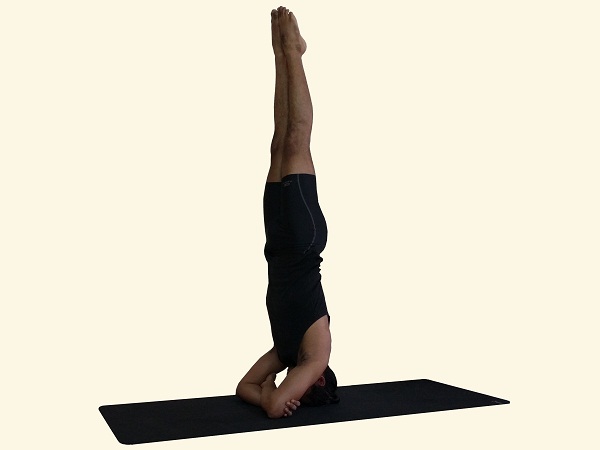Baddha means bound and hasta means hand. This variation of headstand is a little difficult then the normal one. Practice it in front of a wall till you get the confidence of a free headstand. Benefits of all types of headstand are almost the same.

Steps:
- Kneel down on a blanket or a mat
- Fold the arms in front of the chest and catch the right upper arm near the elbow with the left hand. Similarly catch the left upper arm with the right hand.
- Rest the elbows and the folded forearms on the blanket. Bend forward and place the crown of the head on the blanket just beyond the folded forearms.
- Raise the knee from the floor and stretch the legs out straight.
- Press the forarms down, exhale and gently push the trunk slightly back without losing the handgrip and pull the legs off the floor.
- Bring the legs up so that your body is in one straight line, when your body is straight you will feel lightness on your neck.
- Lower down your legs trying to keep the knee straight.
Benefits:
- Strengthens and aligns the spine, neck, shoulders, and arms
- Tones the legs and abdominal muscles
- Helps to prevent water retention in the legs and feet
- Increases the flow of blood to the brain giving more oxygen to the cells
- Can help to treat chronic headaches, anxiety, asthma, sinusitis, hay fever, depression, diabetes, insomnia
- Reduces symptoms of menopause
- Increases mental awareness and clarity
- Calms and soothes the mind
- Helps to re-balance sleep patterns, while decreasing memory loss
- Stimulates and strengthens the lungs, promoting healthy breathing
- Improves digestion
- Stimulates pituitary and pineal glands, which aid growth and the production of sex hormones
- Aids in the relief of tonsillitis, persistent coughing, common cold, bad breath, and palpitations
- Helps overcome problems with the liver, kidneys, stomach, intestines, and reproductive organs by reversing the pull of gravity.
Contraindications:
- High blood pressure, heart disease, thrombosis, arteriosclerosis
- Severe neck problems, like spondylitis
- During headache or migraine,
- Chronic constipation
- Kidney failure
- During pregnancy and menstruation.
- Also due to increased pressure, it is not advised if you are severely near-sighted, if you have weak blood vessels in the eye, conjunctivitis, chronic glaucoma, inflammation of the ears or any form of hemorrhage in the head.
Look for other postures in our asana directory